Earlier this year, TORQ partnered with Iron Sally Coaching to fuel and coach James Wilkinson, a former British Army Corporal who was injured in service in Afghanistan. Here we share his nutritional plan for the Dolomiti Superbike Mountain Bike Marathon with you – his training and event nutrition.
We took part in this project because Sally Bigham of Iron Sally Coaching, a former #TORQFuelled World Class Mountain Bike Marathon Pro approached us with a plan to coach and fuel someone free of charge who had suffered adversity in their life, so that they could benefit psychologically from the achievement of completing a huge challenge. She wanted to help someone and we were 100% behind her – what a great idea! Not only would this person receive free coaching from Sally, but they’d also get free TORQ Nutrition for the duration of their training and event as well as our advice and support, plus free access to the Today’s Plan coaching software package. They also got free entry to the epic Dolomiti Superbike event, accommodation and were supported with travel costs. It was a great deal, but we needed the right person, so we put out an advert through our Have You Got What It Takes campaign and James Wilkinson found us.
About James Wilkinson
James Wilkinson is a former corporal with the Royal Army Veterinary Corps who joined the service in early 2007 and by the end of the year was deployed on his first tour of Afghanistan. In 2011, James was involved in improvised explosive device (IED) attack leaving him with lasting injuries both physically and mentally. Having had numerous surgeries over many years and completed hours of both physical and mental rehabilitation sessions, James thought that he was now ready to take on a new life challenge. To learn more about James, you can read our inspiring From Afghanistan To Dolomite Superbike article.
Having heard about TORQ & Sally Bigham’s Have You Got What It Takes Campaign to train for and race at the Dolomite Superbike (fully funded by TORQ, Sally Bigham and Today’s Plan), James applied for the opportunity and was lucky enough to be selected. To learn more about James, you can read our inspiring From Afghanistan To Dolomite Superbike article. James has also written A Story From The Finish Line to summarise the feelings and emotions on completion of what has been an incredible journey for him and us.

Who Is This Article For?
It’s for you. As we took the time to nutritionally advise James as he trained with Sally for this enormous event, we wanted to document it and write this story so that there’d be take-home messages for others thinking of training for something similar. This story is about training for a Mountain Bike Marathon, but the principles of nutrition will apply to any large endurance event, so please share this with anyone you think might be interested.
The Dolomiti Superbike Race
Referred to as “the most legendary bike race In The Dolomites” Dolomiti Superbike has been on the to-do-list of ambitious mountain bikers all over the world for more than 27 years. The Mountain Bike Marathon race is among those with the highest number of entrants in Europe and enjoys the reputation of being one of the toughest MTB events in the South Tyrol and beyond. The race route incorporates 123km (76 miles) of off road riding with 3400m (11,100ft) of climbing, set in the iconic Dolomites. Under the professional guidance of previous 4 times winner of the Dolomiti Superbike race, Sally Bigham, James trained all aspects of his physiological framework, giving him the very best chance of success at the event.

How Important Is Nutrition?
We hear so often about the training that people do in preparation for a certain race and yet rarely do we hear about the nutritional strategy they have implemented to help maximise the outcome. Not only does the application of correct nutrition during training sessions help to maximise the physiological response to the training, but it also trains the digestive system to cope with race-day fuelling. It also gives you hindsight into the practical fuelling challenges you may face come race day. Let’s be clear though, training nutrition doesn’t simply refer to nutrients taken onboard during and immediately after exercise, although these are critically important, it refers to foods/nutrients consumed in general to support your training load. Successful training involves incrementally increasing your training load and your diet needs to support this.
Let’s start with understanding the different nutrients in our diet and the roles they play in providing energy, physiological support and health.
The Macronutrients
The term ‘Macronutrients’ refers to the main food groups of carbohydrates, proteins and fats, each playing a pivotal role in our biological functioning. These macronutrients become even more important as we add the physiological stress of training for a marathon into the mix. These main food groups give us energy to exercise/train, assist in the post exercise recovery process and help us to maintain our overall health, keeping us free from illness. We’ll look at each one in turn:
Fat: Even the leanest of us store a significant amount of fat, so unlike carbohydrate, it’s not a nutrient we need to search for to fuel endurance exercise – it’s not a fuel we will ever run out of. That said, sourcing fats from the diet assists with the absorption of vitamins A,D,E & K which are known as fat soluble vitamins. Fats also provide structural roles which supports the formation of cell walls, helps regulate cholesterol and even extends as far as supporting brain development. It’s important to note however that fat is exceptionally calories dense, providing 9kcal per gram, so when sourcing fat from the diet, you really should be aiming for quality over quantity. Saturated fats are generally lower quality and typically found in poor quality fatty meats, butter, cream, savoury snacks and processed foods. Unsaturated fats, especially those containing high levels of Omega 3 oils should however be consumed in low quantities and provide the health benefits discussed above. Unsaturated fats with healthy Omega 3 content can be sourced from foods such as oily fish, avocado, nuts and seeds to name a few.
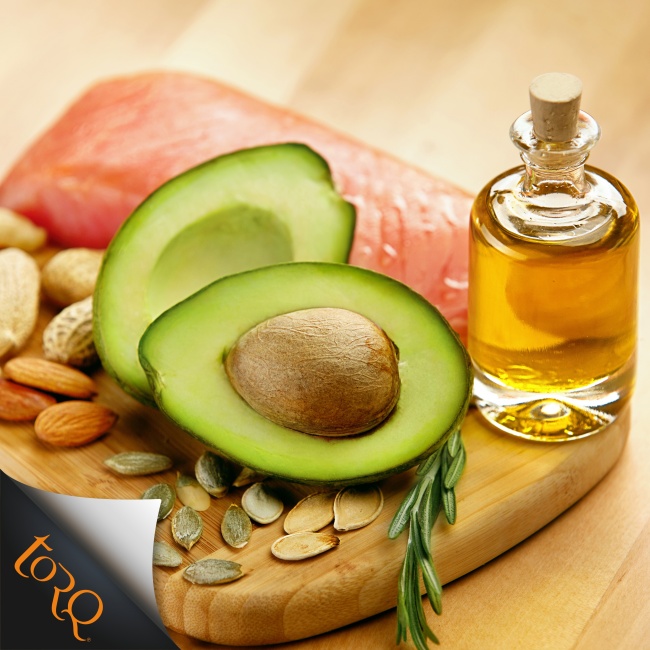
Interestingly, because we’re known to burn a lot of fat as a fuel when we train for a marathon, mistakenly many people think it makes sense to consume plenty of it. This couldn’t be further from the truth, because actually every calorie we consume which is in excess of requirements is stored as fat – so you don’t need to eat fat to retain stores of fat.
Protein: We have discussed protein in great detail in our article Protein, Performance & 20-25g Protein Recipes so please take the time to read it if you would like comprehensive information on this vital nutrient. Protein is responsible for building our physical human structure as well as controlling how the cells within our body function. The human body is made up of tens of thousands of different proteins that make up who we are. From skin, hair, tendons and muscle tissue, to the enzymes that breakdown our food and the hormones that control blood glucose such as insulin, each protein has a specific function. Unlike fat and carbohydrate, protein can’t be stored within the body and so it’s important that we consume it at regular intervals (every 3-4 hours) throughout the day, aiming for around 20g-25g per serve. This becomes incredibly important if you’re training your body for a marathon, because these regular intakes of protein will fast-track recovery and adaptation, helping you to become stronger as well as remain healthy. Our Protein, Performance & 20-25g Protein Recipes article will give you plenty of ideas as to how to find foods and make meals containing 20-25g protein. Our Explore Breakfasts for instance, each contain 25g of protein and can be eaten at any time of day, so are really convenient and effective.
As protein allows us to grow, repair and adapt, it of course plays a critically important role in post-exercise recovery and adaptation. This is why we formulated TORQ Recovery Drink, because it delivers an optimal blend of 20-25g of high quality protein with multiple-transportable carbohydrates (we discuss carbohydrate next) and is to be consumed immediately after exercise when the nutrients are most in demand by the body. Protein consumption of course doesn’t stop there – you need to remember to have more 3-4 hours later and then again 3-4 hours after that! Protein is much less energy dense than fat, providing 4 kcals per gram and can be sourced from foods such as red and white meat, fish, eggs, cheese, tofu, beans, pulses, nuts and seeds. With protein being such an important nutrient to help us repair and adapt from our marathon training, we remind you once again to read our afore mentioned article, where you can learn more about protein, high protein foods and we provide recipes for some delicious meals to build into your weekly menu.
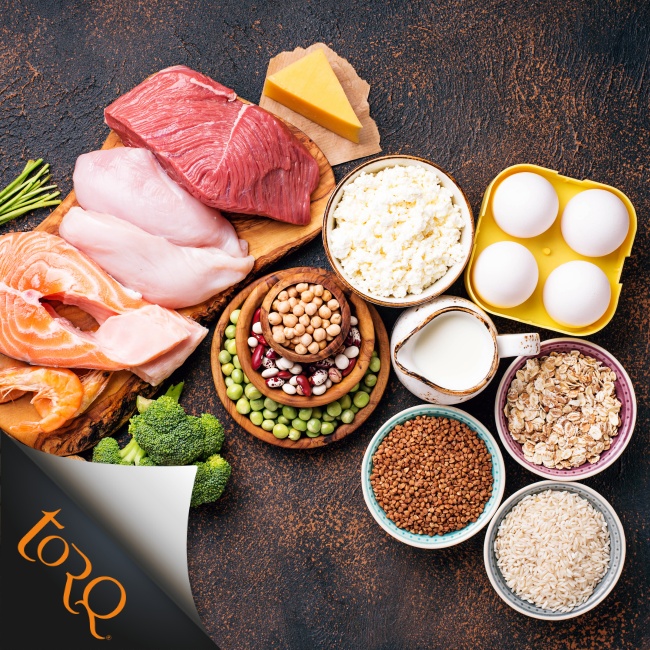
Carbohydrate: The main role of carbohydrate is to provide your working muscle and major organs with fuel to function. Carbohydrates are broken down to produce ATP (the energy currency of our cells) during both light and intense exercise. Carbohydrates are stored, albeit to very limited quantities, within the human body as liver and muscle glycogen, at a maximal quantity of around 500g (2,000kcals). Because carbohydrates can be rapidly broken down for fuel, they become the preferred fuel source as exercise intensity progresses.
Carbohydrates are commonly categorised into two forms, simple and complex variations. Simple sugars are short chain carbohydrate molecules which are sweet and are found naturally in sweet-tasting foods like fruit and honey. Regular sugar (also simple sweet carbohydrate) is added to many processed foods for sweetness, which tend to have a bad reputation from a health perspective, often because they are mixed with higher fat foods to produce, for instance, chocolate, cakes and biscuits. Complex carbohydrates are formed from longer chain carbohydrate molecules, are less sweet and typically found in foods such as rice, pasta, potatoes, grains, and bread. These are generally considered healthier, especially in their wholemeal/wholegrain forms because they contain fibre and a variety of other micronutrients (vitamins & minerals) as well as often some protein. That said, from a functional perspective, carbohydrate is carbohydrate and if you’re putting some serious miles in to your marathon training, simple sugars represent a very handy way of taking on board extra carbohydrate calories – calories that you need. For instance, you will double the carbohydrate content of a piece of toast if you put honey on it! Quite handy if you need the calories and it has the additional benefit of making the bread easier to eat.
During exercise it’s a different story and we will talk about this shortly. Just like protein, the energy density of carbohydrate equates to 4 kcals per gram, yet stores of carbohydrate can be rapidly depleted in as little as 1.5 hours worth of exercise. When stores are entirely depleted, your ability to exercise will cease – this is called ‘the bonk’ in cycling or ‘hitting the wall’ in marathon running. Therefore, the ingestion of carbohydrate, pre, during and post exercise should be considered highly important for anybody training for an endurance event such as an MTB Marathon.
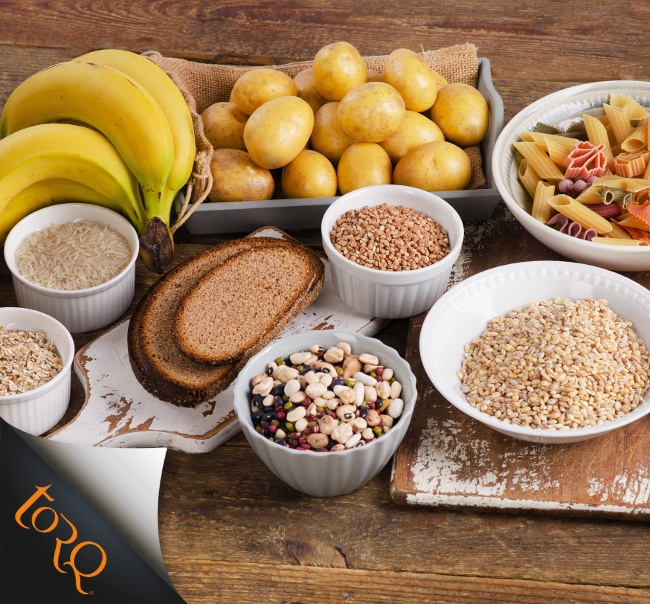
Micronutrients
Micronutrients include vitamins and minerals and are consumed in much smaller quantities than the larger macronutrients. Although we don’t need much in the way of volume when it comes to micronutrients, this doesn’t mean that they’re any less important. Deficiencies however are much less likely to show immediately, so you’re not going to ‘hit the wall’ because you didn’t take a vitamin pill, but over time, your recovery and overall health could be compromised if you neglect this area. You’re asking a lot from your body by training for a marathon, especially over the winter months when your immune system is likely to be in poorer shape, so the best advice we can give is to encourage you to eat plenty of fruit and vegetables and a wide variety of fresh foods. We’re not suggesting that you exclusively eat fresh foods, but the more of them you do, the more micronutrients you’ll get. Many of these foods aren’t rich in calories, so can be used to accompany your macronutrients.
Immune health is an area where you may benefit from a little extra help from taking supplements however, especially over the winter and this is why we developed our Immune System Support Products. We have also produced a comprehensive range of Immune System Support Resources too, which you can read at your leisure. The scientific evidence clearly points to most of us being deficient in Vitamin D over the winter months, Zinc can be depleted during exercise and that there are supplemental interventions we can employ at the first signs of cold or flu.
Quality Nutrition For Quality Training
The human body is an exceptionally complicated structure, regulated by numerous mechanisms in order to maintain a state of homeostasis (balance). When we complete a training session, the core aim of the session should be to disrupt this state of homeostasis, generating training stress and inducing fatigue. Whilst fatigue is typically considered a negative by-product of training, it is actually fundamental to the training process. Referring to the graphic below, the fatigue generated by the training session (Phase I) will result in adaptations specific to the type of training completed.
For example, if you were to complete a 4-hour endurance training ride (Phase I), this will have stressed all of the processes involved in driving the aerobic cardiovascular system. Once you have allowed some time to recover from the training (Phase II) we would expect to see aerobic-specific training adaptations starting to develop. Once fully recovered and adapted, you will now find yourself carrying a new heightened degree of fitness (Phase III).
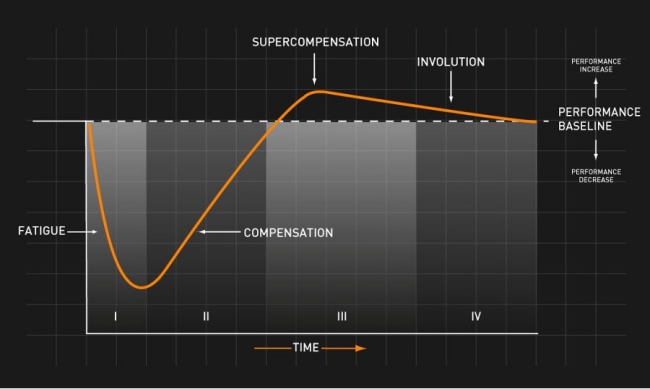
The key to successful training is all about taking advantage of these heightened levels of fitness and then generating a new fatigue stimulus, as demonstrated in the diagram below.
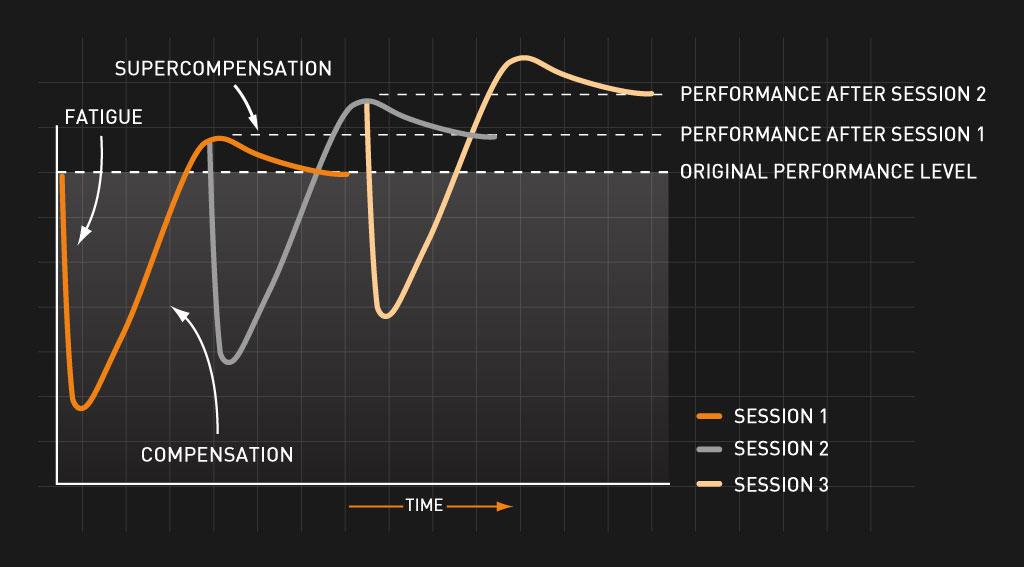
Consuming the correct nutrition at the right times will have a distinct impact on the effectiveness of our recovery and adaption as demonstrated in the diagram below. Consuming a high quality Recovery Drink immediately after exercise will deliver the key 20-25g of protein required as well as a heavy dose of carbohydrate and is by far the single biggest intervention you can make to fast-track your recovery. Remember, the quicker you recover, the sooner you can train again and the greater fitness gains you will achieve before MTB marathon day.
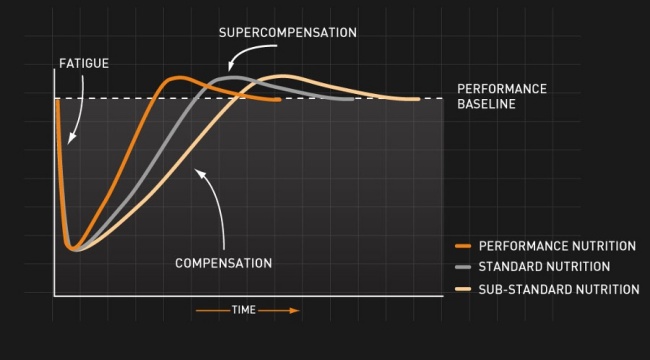
It’s hard to separate the importance of using a Recovery Drink from fuelling your training sessions properly, because the calories consumed whilst exercising are perfectly timed and have a direct impact on how fatigued you will be at the end of your training session. In essence, diligent fuelling will leave your Recovery Drink with less work to do. We will discuss ‘fuelling’ in the next section, but please take the time to watch the video below, which provides a solid summary on how to optimise your recovery.

The video (and previous discussion in this article) highlights how important it is to continue to consume high quality calories (protein and carbohydrate) throughout the day as all of this plays a vital role in your physical recovery and overall health. Remember to consume 20-25g of protein every 3-4 hours and maintain a high carbohydrate diet!
To learn more about the interaction between training and nutrition, we highly recommend reading our Optimal Nutrition article. Also, if you haven’t read our Immune System Support Resources yet, we strongly advise that you do. They explain how consuming carbohydrate during and immediately after exercise helps with immune function and there’s nothing more likely to cause regression in your training than illness. It’s so important that you keep yourself healthy.
You can learn more about Effective Training in this article. Also, if you would like to learn more about how to prepare, train and peak for your MTB marathon, please take the time to read our Periodisation & Peaking series of articles. This will give you an idea of the kinds of initiatives Sally will have implemented with James:
Periodisation & Peaking 1: The Off Season
Periodisation & Peaking 2: Planning Your Training
Periodisation & Peaking 3: Peaking For Competition
Fuelling Your Training Sessions
When we exercise aerobically, typically at a low exercise intensity, both fat and carbohydrate provide the fuel to propel us. However, the proportion of carbohydrate contribution shifts upwards as the aerobic exercise intensity rises and this is shown in the graph below. As exercise intensity increases further, we start to work anaerobically (without the presence of oxygen) where carbohydrate is the only fuel that the body can use. In short, the harder we work, the more carbohydrate we burn and the more carbohydrate we need to consume as fuel to maintain our intensity. You will notice at 70% of our aerobic capacity, carbohydrate becomes the predominant fuel source and this is called the aerobic fuel utilisation crossover.
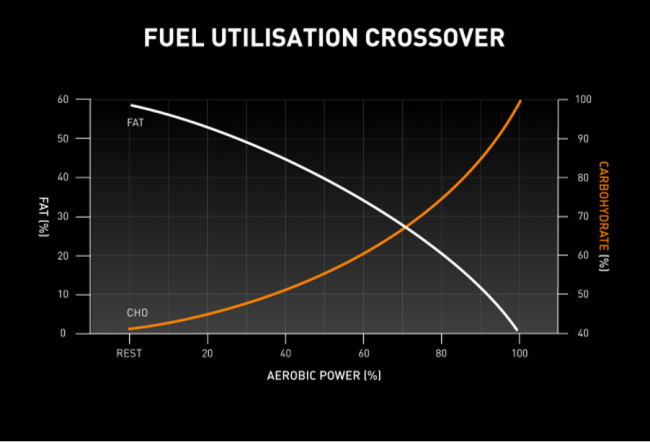
What the graph also highlights is that even at very low exercise intensity of 40% of our aerobic running pace, 50% of the energy contribution is coming from carbohydrate and so if our training run is of long duration at a steady pace, it could certainly still be possible to deplete our stores of carbohydrate if fuelling is neglected. The take home message here is that both high intensity and low intensity exercise drains our carbohydrate stores, it’s just that low intensity exercise does so over a longer time period.
We mentioned earlier that the human body can store about 500g or 2,000kcals of carbohydrate, which will keep you going for some time, but once this stored carbohydrate is used up, you will ‘bonk and will be cycling nowhere! No Carbohydrate = No Performance. People don’t only bonk when doing an event, they do it in training too and it’s not a great place to be. Not only is it a particularly unpleasant experience, but it will also severely impact your recovery.
The way to avoid running out of fuel, or delay the dreaded ‘bonk’ is to fuel with carbohydrate whilst exercising. The Why Fuel video below highlights the importance of fuelling for cyclists and endurance athletes and demonstrates how taking on carbohydrate fuel sources (exogenous fuel) helps to preserve your stored carbohydrate (endogenous fuel). Please take the time to watch it, because it explains the topic far better than we ever could with words. This is a very valuable video to watch.

In summary, you should look to consume a combination of energy drinks, gels, bars and chews during your training rides and should aim for 2-3 TORQ Units per hour as the video explains. Which TORQ units you should consume will depend on both texture/flavour preference and the need to hydrate. The diagram below shows how you should be leaning more towards energy drink units when perspiration rates are higher and more concentrated fuelling units when you’re sweating less. This is an adaptive strategy for fuelling and hydration and one that addresses all of your needs. People often over or under-fuel because they don’t take into account the carbohydrate content of the foods and drinks they are consuming. For instance, an electrolyte tablet (which we don’t recommend you using) contains zero carbohydrate (as well as artificial sweeteners), so will mean that you will need to consume more concentrated fuelling units compared to using an energy drink. Similarly, if you’re using an energy drink in hot weather, be aware of how much you’re consuming, because you may not need to eat many additional TORQ Units. To understand this area fully, please refer to the TORQ Fuelling System.
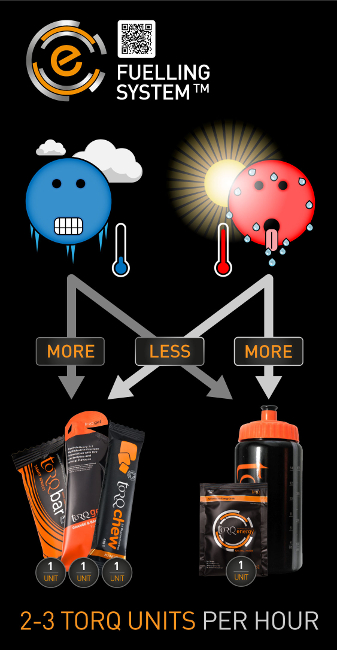
Essentially, irrespective of perspiration rates, your fuelling requirements remain constant, but the more you sweat, the greater the need to replace fluid and vital electrolytes. This why the TORQ Fuelling System works so beautifully, adapting to your hydration needs whilst providing the constant supply of fuel essential for optimal endurance performances.
With the importance of fuelling now understood, the F.I.T.T principles will determine your day-by-day fuelling strategy and whether you should choose to fuel your sessions with 1, 2 or 3 TORQ Units per hour (30, 60 or 90g of carbohydrate).
The F.I.T.T principle is an acronym composed of the 4 methods used to manipulate your training load. These 4 methods include; Frequency (how many times per week you train), Intensity (how hard the session is), Time (how long the session is) and Type (sprint or endurance focused session).
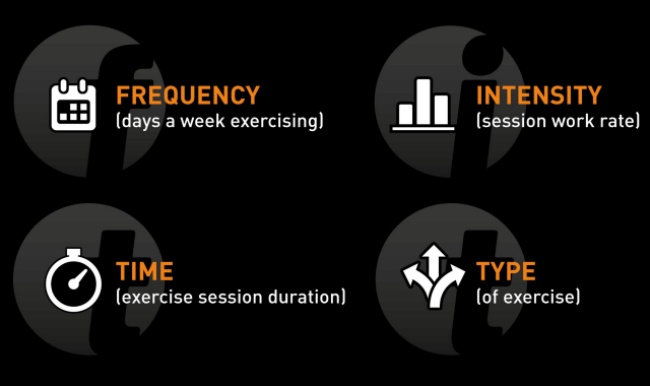
We have already discussed intensity and time, however the two principles yet to be considered are frequency and type. Regarding frequency, we may choose to schedule sessions back-to-back and strategically neglect recovery to generate a deep trough of fatigue, which (if a suitable period of recovery is planned) will generate a significant amount of adaptation.
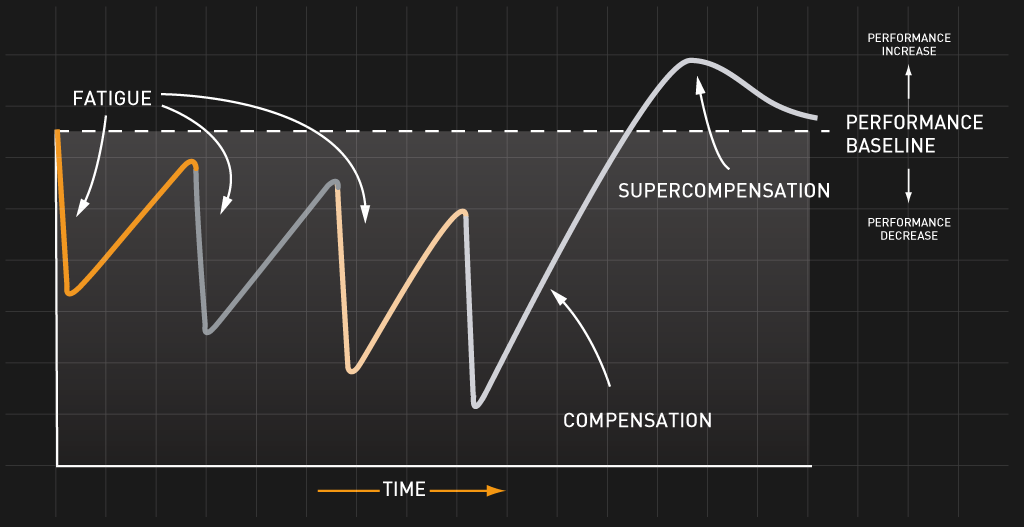
Training in this way could become unmanageable if your nutrition during exercise is neglected. When completing back to back sessions, your window of recovery is limited, so fuelling your training sessions helps to prevent the depletion of carbohydrate (glycogen) from your muscle and liver stores. This means that when you come to consume your recovery drink and subsequent meals, you have less of a deficit to replenish and the recovery between sessions becomes much easier. So, not only does fuelling your training sessions assist with the recovery process, but subsequently it also supports the adaptation process. The more training stress you can generate and the quicker you can recover, the fitter you will become.
The graph below highlights the comparison between a high and low carbohydrate diet and how the two diets impact stored carbohydrate availability over multiple sessions. Interestingly, the same graph could equally represent our performance within each session. As carbohydrate starts to deplete, we will almost certainly see a reduction in our ability to perform.
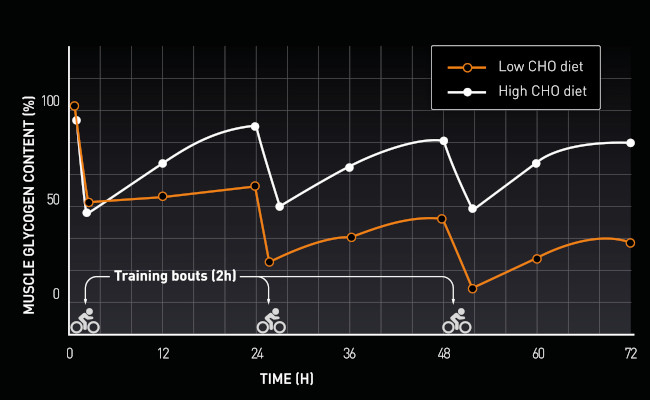
There are times when fuelling your training sessions may not be necessary. This is where we consider the Type (referring to the F.I.T.T principles) of our training. For example, on a short recovery run where the duration and intensity are both low, you will not run the risk of carbohydrate depletion. Also, if you want to introduce some advanced techniques into your training, you could consider some Fasted Training sessions, but these would need to be introduced with care and knowledge. By all means read our article on the subject HERE as there are some gains to be made, but if you’re at all unsure about implementation, stick to the basic principles in this article and you’ll have a great event.
For comprehensive information on how to fuel yourself effectively with TORQ Products, visit our TORQ Fuelling System pages. We make it very easy for you to follow and understand. The take-home message from this section is that on less draining training sessions, you won’t need too fuel much, so could consume 1 TORQ Unit (30g carbs) per hour. For most harder sessions, you should be looking at taking on board 2 TORQ Units (60g carbs) per hour. For particularly tough carbohydrate-draining sessions, you should aim for 3 TORQ Units (90g carbs) per hour and practicing this strategy as you approach MTB Marathon day will train your digestive system, giving you confidence that this strategy can be employed when it really matters during the event.
Carbohydrate Loading: Fuelling Longer Rides
On your longer training sessions, of course you need to fuel, but ensuring that you’ve got plenty of carbohydrate in the tank before you start will be equally as important. If you start with low liver and muscle glycogen stores, it’s likely that you will hit the wall as the amount of carbohydrate we can burn per hour can far exceed our maximal absorption rates of exogenous carbohydrate (fuel) at 90g/hr. Just like filling the petrol tank up in your car before a long drive, you should fill your muscular fuel tank up with carbohydrate before a long run.
Allowing sufficient recovery time prior to your longer sessions and ensuring that your diet is rich in carbohydrate should be enough in the vast majority of situations, but there may be occasions where you want to complete a particularly long ride, perhaps at a higher intensity than you would ordinarily? This is when you should consider carb loading.
When you carb load, we would highly recommended following the 1-day protocol discussed in our Carbohydrate Loading article as this has been shown to be far less disruptive to your life in general, whilst still offering all of the benefits of a traditional 6-day protocol. Don’t just eat more food, be strategic with your meals and increase the amount of carbohydrate within your daily diet to around 70-80% of your daily intake. You may also find it difficult to consume up to 80% of your daily calories from carbohydrate by eating food such as pasta, rice and potatoes, due to their bulky and more fibrous composition. To overcome this you will need to consider incorporating some simple carbohydrates such as jelly babies, wine gums, flavoured rice cakes (sweet or savoury) or even snack on a TORQ Bar or Explore Flapjack. Finally, stay hydrated! To store 1g of glycogen, 3 grams of water is required, so ensure you drink plenty of water and always have a bottle of TORQ Hydration to hand whilst carb loading. Once again, you can learn more about the intricacies of carbohydrate loading by clicking HERE.
Fuelling The Dolomiti Superbike Event
Once again, the advice here that we’ve given James should be no different to the advice we would give to anyone completing a similar event. As James had been training his gut to tolerate the hourly carbohydrate and fluid targets required to meet the demands of the Dolomite Superbike race during his preparation, nothing should have come as a surprise during the event. In fact, his fuelling should have been a well-practiced strategy and therefore his race-day nutritional approach would be no different to that implemented in one of one of his challenging training rides.
The Dolomite Superbike race takes on a considerable amount of elevation gain, a total of 3400 meters of vertical ascent, over a 123km course with technical descents. The combination of these factors (remembering the F.I.T.T principles) would suggest an hourly carbohydrate ingestion target of 90g of carbohydrate per hour. As the Dolomite Superbike is set in the heart of Northern Italy, in July, the environmental temperatures are almost certainly going to be hot, and dehydration will be a significant cause for concern. Therefore, we recommend that a large proportion of James’ carbohydrate comes from TORQ Energy Drink. We recommend targeting 1L of TORQ Energy drink per hour with the aim being to prevent dehydration. Preventing dehydration in hot environmental conditions is critical to maintaining endurance performance as it supports mechanisms such as thermoregulation, cardiovascular function, intestinal absorption and cognitive capacity. To learn more about the role of hydration and the impact it can have on sports performance, take the time to read our Hydration: The Definitive Guide article.
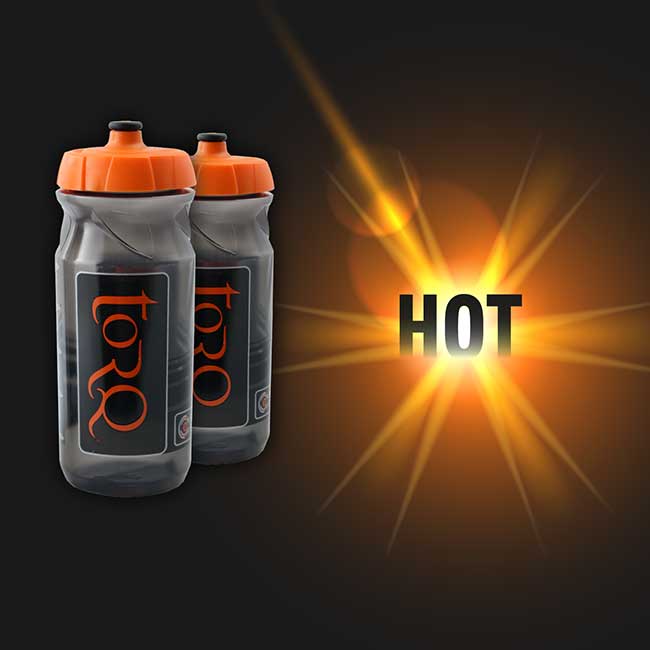
Consuming 1L of TORQ Energy Drink per hour provided 60g of carbohydrate based on the TORQ Fuelling System (2/3 of James’ hourly target) along with a rich concentration of electrolytes meaning the last 30g (per hour) could come from one of TORQ’s concentrated fuelling system products of his choice.
Due to the prolonged, intense nature of the Dolomite Superbike race comes the inevitable developments of fatigue. Commonly, as the body starts to fatigue, we see an increased rating of perceived exertion, loss of focus and decline in mood state. Caffeine has been proven to reduce the rating of perceived exertion, which can help to blunt this negative psychology. Combined with increases in muscular efficiency driven by caffeine consumption and an increased state of mental alertness, focus and mood elevation, these negative feelings can be quickly turned around after a well-timed shot of caffeine. To learn more about the effects of caffeine on sports performance, take the time to read our How Can Caffeine Boost Performance article.
As James reaches the 2/3 point of the race, we would recommend a well-timed shot of caffeine, either from a TORQ Energy Gel With Guarana (89mg per gel), or from TORQ’s Cola Caffeine Energy Drink (100mg per 500ml) with the aim to suppress the negative physiological indications of fatigue and maintain performance to the very end of the race.
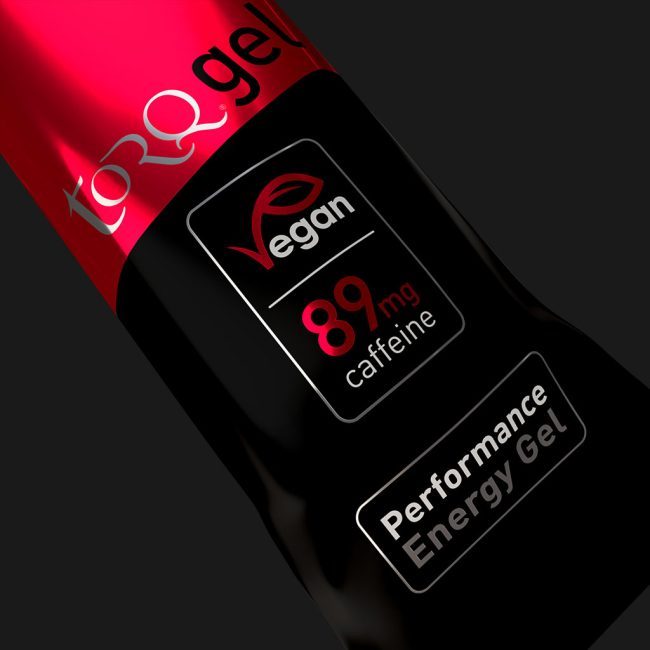
The only thing that we would add is that the day prior to the event, we recommended that James follow a Carbohydrate Loading regimen. This recommendation was no different to the advice given above during his training in preparation for longer rides, but ultimately it ensured that his internal ‘endogenous’ carbohydrate stores were fully loaded on the start line of the event. Once again, to learn more about how to Carbohydrate Load, read our article on the subject.
Congratulations James!
We would like to congratulate James on the immense achievement in completing the Dolomiti Superbike event. James has written A Story From The Finish Line to summarise the feelings and emotions on completion of what has been an incredible journey. Click HERE to read.
If you are looking to complete and MTB Marathon or similar endurance event yourself, we wish you the best of luck and hope that you’ve found this resource useful in your preparation.
If you have any questions about this article or any other subject, please don’t hesitate in contacting us at enquiries@torqfitness.co.uk or phone 0344 332 0852.






